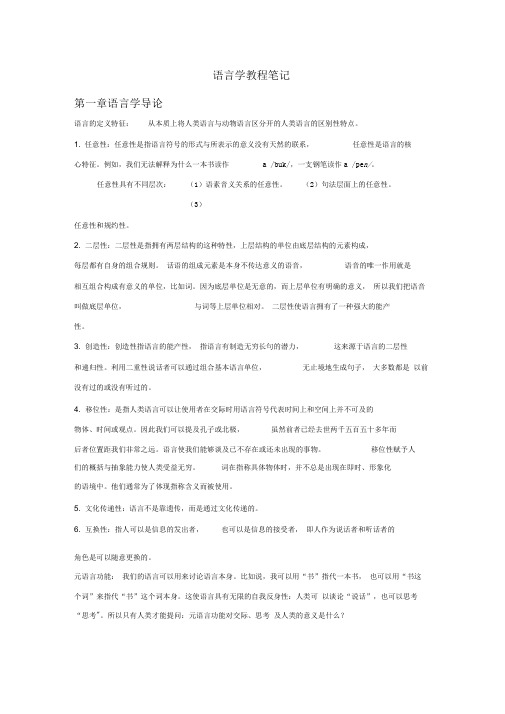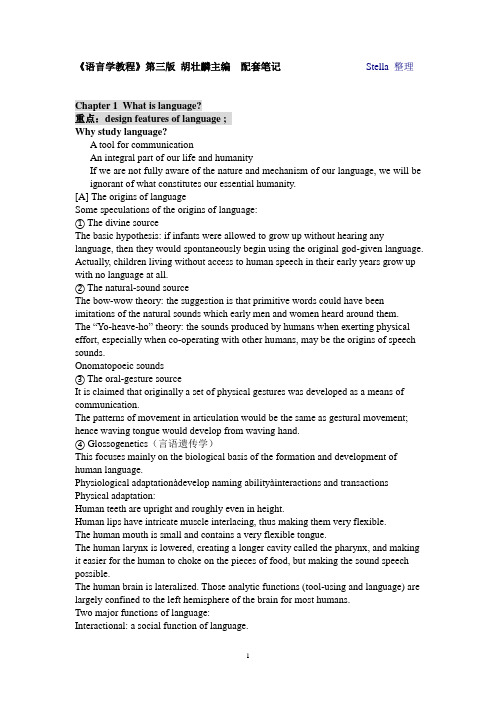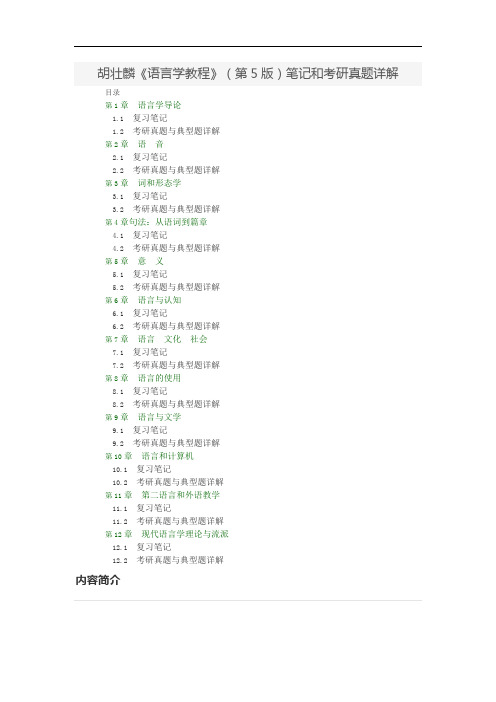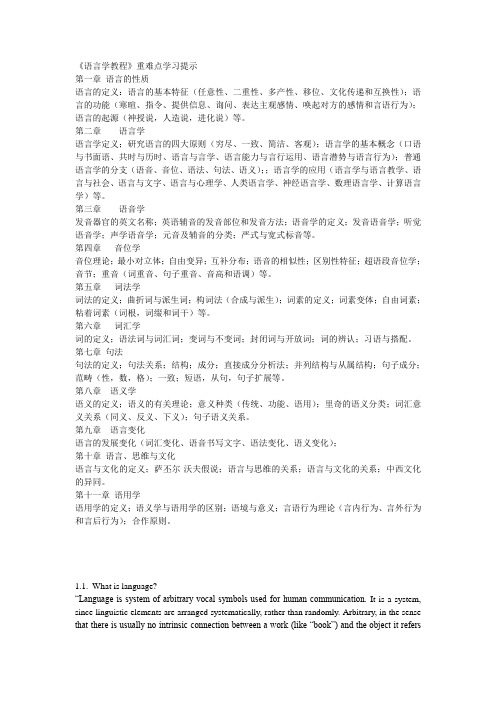《语言学教程》中文笔记(完整)
《语言学教程》中文笔记(完整)

语言学教程笔记第一章语言学导论语言的定义特征:从本质上将人类语言与动物语言区分开的人类语言的区别性特点。
1. 任意性:任意性是指语言符号的形式与所表示的意义没有天然的联系,任意性是语言的核心特征。
例如,我们无法解释为什么一本书读作 a /buk/,一支钢笔读作a /pe n/。
任意性具有不同层次:(1)语素音义关系的任意性。
(2)句法层面上的任意性。
(3)任意性和规约性。
2. 二层性:二层性是指拥有两层结构的这种特性,上层结构的单位由底层结构的元素构成,每层都有自身的组合规则。
话语的组成元素是本身不传达意义的语音,语音的唯一作用就是相互组合构成有意义的单位,比如词。
因为底层单位是无意的,而上层单位有明确的意义,所以我们把语音叫做底层单位,与词等上层单位相对。
二层性使语言拥有了一种强大的能产性。
3. 创造性:创造性指语言的能产性,指语言有制造无穷长句的潜力,这来源于语言的二层性和递归性。
利用二重性说话者可以通过组合基本语言单位,无止境地生成句子,大多数都是以前没有过的或没有听过的。
4. 移位性:是指人类语言可以让使用者在交际时用语言符号代表时间上和空间上并不可及的物体、时间或观点。
因此我们可以提及孔子或北极,虽然前者已经去世两千五百五十多年而后者位置距我们非常之远。
语言使我们能够谈及已不存在或还未出现的事物。
移位性赋予人们的概括与抽象能力使人类受益无穷。
词在指称具体物体时,并不总是出现在即时、形象化的语境中。
他们通常为了体现指称含义而被使用。
5. 文化传递性:语言不是靠遗传,而是通过文化传递的。
6. 互换性:指人可以是信息的发出者,也可以是信息的接受者,即人作为说话者和听话者的角色是可以随意更换的。
元语言功能:我们的语言可以用来讨论语言本身。
比如说,我可以用“书”指代一本书,也可以用“书这个词”来指代“书”这个词本身。
这使语言具有无限的自我反身性:人类可以谈论“说话”,也可以思考“思考"。
语言学教程第三版___配套笔记

《语言学教程》第三版胡壮麟主编配套笔记Stella 整理Chapter 1 What is language?重点:design features of language ;Why study language?A tool for communicationAn integral part of our life and humanityIf we are not fully aware of the nature and mechanism of our language, we will be ignorant of what constitutes our essential humanity.[A] The origins of languageSome speculations of the origins of language:① The divine sourceThe basic hypothesis: if infants were allowed to grow up without hearing any language, then they would spontaneously begin using the original god-given language. Actually, children living without access to human speech in their early years grow up with no language at all.② The natural-sound sourceThe bow-wow theory: the suggestion is that primitive words could have been imitations of the natural sounds which early men and women heard around them.The “Yo-heave-ho” theory: the sounds produced by humans when exerting physical effort, especially when co-operating with other humans, may be the origins of speech sounds.Onomatopoeic sounds③ The oral-gesture sourceIt is claimed that originally a set of physical gestures was developed as a means of communication.The patterns of movement in articulation would be the same as gestural movement; hence waving tongue would develop from waving hand.④ Glossogenetics(言语遗传学)This focuses mainly on the biological basis of the formation and development of human language.Physiological adaptationàdevelop naming abilityàinteractions and transactions Physical adaptation:Human teeth are upright and roughly even in height.Human lips have intricate muscle interlacing, thus making them very flexible.The human mouth is small and contains a very flexible tongue.The human larynx is lowered, creating a longer cavity called the pharynx, and making it easier for the human to choke on the pieces of food, but making the sound speech possible.The human brain is lateralized. Those analytic functions (tool-using and language) are largely confined to the left hemisphere of the brain for most humans.Two major functions of language:Interactional: a social function of language.Transactional: a function involving the communication of knowledge and information [B] The properties of languageLanguage is a system of arbitrary vocal symbols used for human communication.a) System: combined together according to rulesb) Arbitrary: no intrinsic connection between the word “pen” and the thing in the world which it refers toc) V ocal: the primary medium is sound for all languagesd) Human: language is human-specific(交际性与信息性)Communicative vs. Informative:Communicative: intentionally using language to communicate something Informative: through/via a number of signals that are not intentionally sentDesign features refers to the defining properties of human language that distinguish it from any animal system of communication① Displacement(跨时空性,移位性)Language can be used to refer to contexts removed from the immediate situations of the speaker (refer to past and future time and to other locations)我们能用语言可以表达许多不在场的东西② Arbitrariness(任意性)There is no logical or natural connection between a linguistic form (either sound or word) and its meaning.E.g. “house” uchi (Japanese)Mansion (French)房子(Chinese)While language is arbitrary by nature, it is not entirely arbitrary.a) echo of the sounds of objects or activities: onomatopoeic wordsb) some compound words③Creativity(创造性)Language is productive in that it makes possible the construction and interpretation of new signals by its users. (novel utterances are continually being created.)④ Cultural transition(文化传递性)While human capacity for language has a genetic basis (everyone was born with the ability to acquire a language), the details of any language system are not genetically transmitted, but instead have to be taught and learnt.⑤ Discreteness(可分离性)Each sound in the language is treated as discrete.⑥ Duality(双重结构性,两重性或二元性)Language is organized at two levels or layers simultaneously. The lower or basic level is a structure of sounds which are meaningless.The higher level is morpheme or word (double articulation)the higher level ----words which are meaningfulthe lower or the basic level----sounds which are meaningless, but can be grouped and regrouped into words.The above 6 properties may be taken as the core features of human language.V ocal-auditory channel, reciprocity, specialization, non-directionality, or rapid fade, these properties are best treated as ways of describing human language, but not as a means of distinguishing it from other systems of communication.[C] The development of written language① pictograms & ideograms(象形文字和表意文字)Pictogram: when some of the pictures came to represent particular images in a consistent way, we can begin to describe the product as a form of picture-writing, or pictograms.Ideogram: the picture developed as more abstract and used other than its entity is considered to be part of a system of idea-writing, or ideogramHieroglyph: 古埃及象形文字② Logograms(语标书写法)When symbols come to be used to represent words in a language, they are described as examples of word-writing, or logograms.“Arbitrariness”—a writing system which was word-based had come into existence. Cuneiform--楔形文字—the Sumerians (5000 and 6000 years ago)Chinese is one example of its modern writing system.Advantages: two different dialects can be based on the same writing system. Disadvantages: vast number of different written forms.③ Syllabic writing(音节书写法)When a writing system employs a set of symbols which represent the pronunciations of syllables, it is described as syllabic writing.The Phoenicians: the first human beings that applied the full use of a syllabic writing system (ca 1000 BC)④ Alphabetic writing(字母书写法)Semitic languages (Arabic and Hebrew): first applied this ruleThe Greeks: taking the inherently syllabic system from the Phoenicians via the RomansLatin alphabet and Cyrillic alphabet (Slavic languages)⑤ Rebus writingRobus writing evolves a process whereby the symbol used for an entity comes to be used for the sound of the spoken word used for that entity.Chapter 2 What is linguistics?重点:some important distinctions in linguistics[A] The definition of linguisticsLinguistics is generally defined as the scientific study of language.It is a major branch of social science. Linguistics studies not just one language of any society, but the language of all human society, language in general.Process of linguistic study: observation------generalization-----hypothesis------tested by further observation------theory① Certain linguistic facts are observed, generalization are formed;② Hypotheses are formulated;③ Hypotheses are tested by further observations;④ A linguistic theory is constructed.Language is a system of arbitrary vocal symbols used for human communication. [B] The scope of linguistics普通语言学General linguistics: the study of language as a whole语音学Phonetics: the general study of the characteristics of speech sounds (or the study of the phonic medium of language) (How speech sounds are produced and classified)音韵学Phonology:is essentially the description of the systems and patterns语音of speech sounds in a language.(How sounds form systems and function to convey meaning)形态学Morphology:the study of the way in which are arranged to form words (how morphemes are combined to form句法学Syntax: the study of those rules that govern the combination of words to form permissible sentences (how morphemes and words are combined to form sentences) 语义学Semantics: the study of meaning in abstraction 抽象语用学Pragmatics: the study of meaning in context of use使用情境社会语言学Sociolinguistics: the study of language with reference to society Psycholinguistics: the study of language with reference to the workings of the mind Applied linguistics: the application of linguistics principles and theories to language teaching and learningAnthropological linguistics, neurological linguistics; mathematical linguistics; mathematical linguistics; computational linguistics[C] Some important distinctions in linguistics① Prescriptive vs. DescriptiveThey represent two different types of linguistic study.规定式Prescriptive---a term used to characterize any approach which attempt to lay down rules of correctness as to how language should be used. (how they ought to be)描写式Descriptive---to describe the fact of linguistic usage as they are, and not how they ought to be, with reference to some real or imagined ideal state.(how things are)② Synchronic vs. DiachronicThe description of a language at some point in time;The description of a language as it changes through time.Synchronic (linguistics)---languages are studied at a theoretic point in time: one describes a ‘state’ of language, disregarding whatever changes might be taking place. Diachronic----languages are studied from point of view of their historical development–for example, the changes which have taken place between Old and Modern English could be described in phonological音韵学的, grammatical语法的and semantic语义学terms.T he description of a language at some point of time in history is a synchronic study; thedescription of language as it changes through time is a diachronic study. A diachronic study is a historical study; it studies the historical development of language over a period of time. Most grammars are synchronic. That is, they try to give a description of how a language is used at the present day. Diachronic study may recall to us the changes a language has undergone, for example, what phonological, grammatical and semantic changes have taken place from Old English period to the present day English.③ Speech and writing语言和言语Spoken language is primary, not the written1)Historically, speech is prior to writing.2)Genetically, children learn to speak before they are able to write.3)Functionally, spoken form is more important than written form in language use. ④ Langue and paroleProposed by Swiss linguists F. de Sausse (sociological)--“father of modern linguistics”.现代语言学之父现代结构主义语言学创始人:Ferdinand de saussure提出语言学中最重要的概念对之一:语言与言语language and parole ,语言之语言系统的整体,言语则只待某个个体在实际语言使用环境中说出的具体话语。
胡壮麟《语言学教程》(第5版)笔记和考研真题详解

胡壮麟《语言学教程》(第5版)笔记和考研真题详解目录第1章语言学导论1.1复习笔记1.2考研真题与典型题详解第2章语音2.1复习笔记2.2考研真题与典型题详解第3章词和形态学3.1复习笔记3.2考研真题与典型题详解第4章句法:从语词到篇章4.1复习笔记4.2考研真题与典型题详解第5章意义5.1复习笔记5.2考研真题与典型题详解第6章语言与认知6.1复习笔记6.2考研真题与典型题详解第7章语言文化社会7.1复习笔记7.2考研真题与典型题详解第8章语言的使用8.1复习笔记8.2考研真题与典型题详解第9章语言与文学9.1复习笔记9.2考研真题与典型题详解第10章语言和计算机10.1复习笔记10.2考研真题与典型题详解第11章第二语言和外语教学11.1复习笔记11.2考研真题与典型题详解第12章现代语言学理论与流派12.1复习笔记12.2考研真题与典型题详解内容简介作为《语言学教程》(第5版)(胡壮麟主编,北京大学出版社)的学习辅导书,全书完全遵循该教材的章目编排,共分12章,每章由两部分组成:第一部分为复习笔记(中英文对照),总结本章的重点难点;第二部分是考研真题与典型题详解,精选名校经典考研真题及相关习题,并提供了详细的参考答案。
本书具有以下几个方面的特点:1.梳理章节脉络,浓缩内容精华。
每章的复习笔记以该教材为主并结合其他教材对本章的重难点知识进行了整理,并参考了国内名校名师讲授该教材的课堂笔记,因此,本书的内容几乎浓缩了经典教材的知识精华。
2.中英双语对照,凸显难点要点。
本书章节笔记采用了中英文对照的形式,强化对重要难点知识的理解和运用。
3.精选考研真题,补充难点习题。
本书精选名校考研真题及相关习题,并提供答案和详解。
所选真题和习题基本体现了各个章节的考点和难点,但又不完全局限于教材内容,是对教材内容极好的补充。
另外,在笔记部分,对于在《语言学教程》第三版或第四版提到而第五版删减的知识点我们也予以保留,并用“*”标明,部分院校考研真题依旧会涉及这些知识点的考查。
(完整版)胡壮麟语言学教程笔记、重点全解

(完整版)胡壮麟语言学教程笔记、重点全解《语言学教程》重难点学习提示第一章语言的性质语言的定义:语言的基本特征(任意性、二重性、多产性、移位、文化传递和互换性);语言的功能(寒暄、指令、提供信息、询问、表达主观感情、唤起对方的感情和言语行为);语言的起源(神授说,人造说,进化说)等。
第二章语言学语言学定义;研究语言的四大原则(穷尽、一致、简洁、客观);语言学的基本概念(口语与书面语、共时与历时、语言与言学、语言能力与言行运用、语言潜势与语言行为);普通语言学的分支(语音、音位、语法、句法、语义);;语言学的应用(语言学与语言教学、语言与社会、语言与文字、语言与心理学、人类语言学、神经语言学、数理语言学、计算语言学)等。
第三章语音学发音器官的英文名称;英语辅音的发音部位和发音方法;语音学的定义;发音语音学;听觉语音学;声学语音学;元音及辅音的分类;严式与宽式标音等。
第四章音位学音位理论;最小对立体;自由变异;互补分布;语音的相似性;区别性特征;超语段音位学;音节;重音(词重音、句子重音、音高和语调)等。
第五章词法学词法的定义;曲折词与派生词;构词法(合成与派生);词素的定义;词素变体;自由词素;粘着词素(词根,词缀和词干)等。
第六章词汇学词的定义;语法词与词汇词;变词与不变词;封闭词与开放词;词的辨认;习语与搭配。
第七章句法句法的定义;句法关系;结构;成分;直接成分分析法;并列结构与从属结构;句子成分;范畴(性,数,格);一致;短语,从句,句子扩展等。
第八章语义学语义的定义;语义的有关理论;意义种类(传统、功能、语用);里奇的语义分类;词汇意义关系(同义、反义、下义);句子语义关系。
第九章语言变化语言的发展变化(词汇变化、语音书写文字、语法变化、语义变化);第十章语言、思维与文化语言与文化的定义;萨丕尔-沃夫假说;语言与思维的关系;语言与文化的关系;中西文化的异同。
第十一章语用学语用学的定义;语义学与语用学的区别;语境与意义;言语行为理论(言内行为、言外行为和言后行为);合作原则。
胡壮麟《语言学教程》笔记第8-9章

Chapter 8 Language in Use1. 语义学与语用学的区别1.1 语用学(Pragmatics)Pragmatics is the study of the use of language in communication, particularly the relationships between sentences and the contexts and situations in which they are used.(语用学是研究语言实际运用的学科,集中研究说话人意义、话语意义或语境意义。
)1.2 区别Pragmatics is sometimes contrasted with semantics, which deals with meaning without reference to the users and communicative functions of sentences.(语用学主要研究在特定的语境中说话人所想要表达的意义,语义学研究的句子的字面意义,通常不考虑语境。
)2. 合作原则及其准则(Herbert Paul Grice)2.1. 合作原则(Cooperative Principle)说话人经常在话语中传达着比话语表层更多的信息,听话人也能够明白说话人所要表达的意思。
格莱斯认为一定存在一些管理这些话语产生和理解的机制。
他把这种机制称作合作原则。
2.2. 准则(maxims)数量准则(quantity)①使你的话语如(交谈的当前目的)所要求的那样信息充分。
②不要使你的话语比要求的信息更充分。
质量准则(quality)设法使你的话语真实①不要讲明知是虚假的话②不要说没证据的话关系准则(relation)所谈内容要密切相关方式准则(manner)要清晰。
①避免含糊不清②避免歧义③要简练(避免冗长)④要有序3. 言语行为理论(Speech Act Theory)---John Austin3.1. 施为句&叙事句(Performatives & Constatives)施为句是用来做事的,既不陈述事实,也不描述情况,且不能验证真假;叙事句要么用于陈述,要么用于验证,可以验证真假。
胡壮麟语言学教程笔记重点

《语言学教程》重难点学习提示第一章语言的性质语言的定义:语言的基本特征(任意性、二重性、多产性、移位、文化传递和互换性);语言的功能(寒暄、指令、提供信息、询问、表达主观感情、唤起对方的感情和言语行为);语言的起源(神授说,人造说,进化说)等。
第二章语言学语言学定义;研究语言的四大原则(穷尽、一致、简洁、客观);语言学的基本概念(口语与书面语、共时与历时、语言与言学、语言能力与言行运用、语言潜势与语言行为);普通语言学的分支(语音、音位、语法、句法、语义);;语言学的应用(语言学与语言教学、语言与社会、语言与文字、语言与心理学、人类语言学、神经语言学、数理语言学、计算语言学)等。
第三章语音学发音器官的英文名称;英语辅音的发音部位和发音方法;语音学的定义;发音语音学;听觉语音学;声学语音学;元音及辅音的分类;严式与宽式标音等。
第四章音位学音位理论;最小对立体;自由变异;互补分布;语音的相似性;区别性特征;超语段音位学;音节;重音(词重音、句子重音、音高和语调)等。
第五章词法学词法的定义;曲折词与派生词;构词法(合成与派生);词素的定义;词素变体;自由词素;粘着词素(词根,词缀和词干)等。
第六章词汇学词的定义;语法词与词汇词;变词与不变词;封闭词与开放词;词的辨认;习语与搭配。
第七章句法句法的定义;句法关系;结构;成分;直接成分分析法;并列结构与从属结构;句子成分;范畴(性,数,格);一致;短语,从句,句子扩展等。
第八章语义学语义的定义;语义的有关理论;意义种类(传统、功能、语用);里奇的语义分类;词汇意义关系(同义、反义、下义);句子语义关系。
第九章语言变化语言的发展变化(词汇变化、语音书写文字、语法变化、语义变化);第十章语言、思维与文化语言与文化的定义;萨丕尔-沃夫假说;语言与思维的关系;语言与文化的关系;中西文化的异同。
第十一章语用学语用学的定义;语义学与语用学的区别;语境与意义;言语行为理论(言内行为、言外行为和言后行为);合作原则。
胡壮麟语言学教程笔记重点

《语言学教程》重难点学习提示第一章语言的性质语言的定义:语言的基本特征(任意性、二重性、多产性、移位、文化传递和互换性);语言的功能(寒暄、指令、提供信息、询问、表达主观感情、唤起对方的感情和言语行为);语言的起源(神授说,人造说,进化说)等。
第二章语言学语言学定义;研究语言的四大原则(穷尽、一致、简洁、客观);语言学的基本概念(口语与书面语、共时与历时、语言与言学、语言能力与言行运用、语言潜势与语言行为);普通语言学的分支(语音、音位、语法、句法、语义);;语言学的应用(语言学与语言教学、语言与社会、语言与文字、语言与心理学、人类语言学、神经语言学、数理语言学、计算语言学)等。
第三章语音学发音器官的英文名称;英语辅音的发音部位和发音方法;语音学的定义;发音语音学;听觉语音学;声学语音学;元音及辅音的分类;严式与宽式标音等。
第四章音位学音位理论;最小对立体;自由变异;互补分布;语音的相似性;区别性特征;超语段音位学;音节;重音(词重音、句子重音、音高和语调)等。
第五章词法学词法的定义;曲折词与派生词;构词法(合成与派生);词素的定义;词素变体;自由词素;粘着词素(词根,词缀和词干)等。
第六章词汇学词的定义;语法词与词汇词;变词与不变词;封闭词与开放词;词的辨认;习语与搭配。
第七章句法句法的定义;句法关系;结构;成分;直接成分分析法;并列结构与从属结构;句子成分;范畴(性,数,格);一致;短语,从句,句子扩展等。
第八章语义学语义的定义;语义的有关理论;意义种类(传统、功能、语用);里奇的语义分类;词汇意义关系(同义、反义、下义);句子语义关系。
第九章语言变化语言的发展变化(词汇变化、语音书写文字、语法变化、语义变化);第十章语言、思维与文化语言与文化的定义;萨丕尔-沃夫假说;语言与思维的关系;语言与文化的关系;中西文化的异同。
第十一章语用学语用学的定义;语义学与语用学的区别;语境与意义;言语行为理论(言内行为、言外行为和言后行为);合作原则。
语言学教程课堂笔记

语言学教程课堂笔记第一章导论一、性质、对象、任务语言学的性质:既古老又年轻的学科,介于自然科学与社会科学之间的学科。
语言学的研究对象:人类自然语言语言学的任务:⑴“描写—解释”层次。
从宏观、微观两个方面描写和解释语言现象、语言的结构规律和应用方式。
使人们懂得关于语言的理性知识。
宏观上:把语言作为一个整体对象来研究,研究它的起源、发展、本质、功能,它和思维、意识的关系等等。
微观上:对语言内部结构进行研究,研究语言内部的结构规律,各要素的关系及发展、演变等。
⑵“认知—思维”层次。
探索人类语言符号行为的奥秘,语言是怎样组织意义的,语言是怎样划分世界从而把现实符号化的,人是怎样在思维和交际中运用语言符号的,语言和心灵的关系是怎样的,语言和文化的关系是怎样的。
⑶“技术—实用层次。
积极地为计算机对语言文字进行信息处理等工程技术服务,为言语矫治等语言病理的治疗工作服务,或者为语言教学、外语教学等服务。
二、语言学的分类⑴根据研究性质、范畴和对象,可分为理论语言学和应用语言学A、理论语言学:是语言学的主体,是研究语言的功能和结构的一般理论。
B、应用语言学:研究语言应用的一切学科,包括语言教学、机器翻译、失语症治疗、语言规划。
⑵从研究对象的范围上分,语言学可分为具体语言学和普通语言学。
三、语言学发展简史⑴传统语言学【语文学(语言文字学)】时期1、时间与特征:一般讲19世纪历史比较语言学产生以前的时期称为“传统语言学时期”、“古典语文学时期”。
这一时期,语言研究处于附庸地位。
还没有发展为独立的学科。
主要是为经典作注解。
2、传统语言学的三大发源地:古希腊—罗马、古印度和古代中国3、传统语言学的作用⑵索绪尔语言学理论1、区分语言(language)和言语(parole)语言:从言语中概括出来为社会公认的词语和规则的总和。
言语:个人说或写的行为和结果2、区别组合关系和聚合关系3、语言和言语的关系:A、一般和个别B、抽象和具体四、语言学的功能(为什么要学语言学概论)1、便与从事与语言相关的工作2、有利于语言规划、信息处理等语言应用3、便于观察语言现象、发现并解释语言规律4、便于提高发现、分析与解决问题的能力5、在语言理论的指导下,透过语言使用我们可以洞悉人类心理的奥秘,为更好地掌握和利用心智打下基础五、怎样学习语言学概论1、勤观察,培养对语言现象的敏锐洞察力2、多思考,培养强烈的问题求解意识3、三个充分:观察充分、描写充分、解释充分第二章语言的本质与起源一、语言的本质(什么是语言?)1、①(为什么)语言是人类特有的、②(为什么是)最重要的全民交际工具。
- 1、下载文档前请自行甄别文档内容的完整性,平台不提供额外的编辑、内容补充、找答案等附加服务。
- 2、"仅部分预览"的文档,不可在线预览部分如存在完整性等问题,可反馈申请退款(可完整预览的文档不适用该条件!)。
- 3、如文档侵犯您的权益,请联系客服反馈,我们会尽快为您处理(人工客服工作时间:9:00-18:30)。
语言学教程笔记第一章语言学导论语言的定义特征:从本质上将人类语言与动物语言区分开的人类语言的区别性特点。
1.任意性:任意性是指语言符号的形式与所表示的意义没有天然的联系,任意性是语言的核心特征。
例如,我们无法解释为什么一本书读作a /buk/,一支钢笔读作a /pen/。
任意性具有不同层次:(1)语素音义关系的任意性。
(2)句法层面上的任意性。
(3)任意性和规约性。
2.二层性:二层性是指拥有两层结构的这种特性,上层结构的单位由底层结构的元素构成,每层都有自身的组合规则。
话语的组成元素是本身不传达意义的语音,语音的唯一作用就是相互组合构成有意义的单位,比如词。
因为底层单位是无意的,而上层单位有明确的意义,所以我们把语音叫做底层单位,与词等上层单位相对。
二层性使语言拥有了一种强大的能产性。
3.创造性:创造性指语言的能产性,指语言有制造无穷长句的潜力,这来源于语言的二层性和递归性。
利用二重性说话者可以通过组合基本语言单位,无止境地生成句子,大多数都是以前没有过的或没有听过的。
4.移位性:是指人类语言可以让使用者在交际时用语言符号代表时间上和空间上并不可及的物体、时间或观点。
因此我们可以提及孔子或北极,虽然前者已经去世两千五百五十多年而后者位置距我们非常之远。
语言使我们能够谈及已不存在或还未出现的事物。
移位性赋予人们的概括与抽象能力使人类受益无穷。
词在指称具体物体时,并不总是出现在即时、形象化的语境中。
他们通常为了体现指称含义而被使用。
5.文化传递性:语言不是靠遗传,而是通过文化传递的。
6.互换性:指人可以是信息的发出者,也可以是信息的接受者,即人作为说话者和听话者的角色是可以随意更换的。
元语言功能:我们的语言可以用来讨论语言本身。
比如说,我可以用“书”指代一本书,也可以用“书这个词”来指代“书”这个词本身。
这使语言具有无限的自我反身性:人类可以谈论“说话”,也可以思考“思考”。
所以只有人类才能提问:元语言功能对交际、思考及人类的意义是什么?语言学的一些重要区别1.“描写式”和“规范式”描写式:客观系统地记录一种语言的模式和用法或变化。
规定式:对语言正确用法的权威性规定。
“共时”和“历时”共时:当我们集中在某一点时间来研究语言时就叫做共时语言学。
历时:当我们研究随着时间发展的语言时就叫做历时语言学。
“语言”和“言语”语言:一个语言群体的所有成员所共有的抽象的语言系统。
言语:语言的具体实现和运用。
“语言能力”和“语言运用”语言能力:对于一门语言的语法规则系统的无意识获得的知识。
语言运用:人们说话写作时实际使用的语言。
第二章语音语音学:对语音的发生、传递和感知的研究。
可以分为三个主要的研究领域:发音语音学、声学语音学和感知(听觉)语音学。
1.发音语音学:对语音发生的研究,或研究语音是如何产生的。
2.声学语音学:研究语音的物质特征。
3.感知(听觉)语音学:研究语音的感知。
音系学:对各种语言的语音模式和语音系统的研究,其目的是发现语言中支配语音组合方式的规律并解释语音中出现的变化。
音系学以音位为起点来处理语言的语音系统,音位是语言中能够区分意义的最小的语音单位。
发音器官:人体参与语音发声的部分。
带声性:指声带的振动。
当声带靠拢(贴近),气流使其产生振动,形成的发音叫“带声音”;当声带分离,气流容易通过,发出的音就是“不带声音”。
国际音标:1888年以来,由国际语音学会设计的一套表格形式的标准语音符号(国际音标表),经不断修改,反映了新的发现和语音学理论与实践中的变化。
最新版国际音标表于1993年修订,2005年再改,见本教材第28页。
辅音:音段的一个主要分类,由于声道紧闭,或声道变窄程度达到气流无法排出,一旦排出,就会产生可闻的摩擦,这样产生的音叫辅音。
元音:音段的一个主要分类,发音时不发生声道的阻碍,气流可以相对无阻地从口腔或鼻腔排出。
(元音和辅音的根本区别在于气流是否受阻。
)基本元音:一套人为确定的、固定不变的元音音质,为实际语言中的元音描写提供一个参照的框架。
八个主要基本元音为:CV1[i],CV2[e],CV3[ε],CV4[a],CV5[α],CV6[ɔ],CV7[o],CV8[u],前面5个是展唇元音,后面3个是圆唇元音。
发音方式:指完成发音过程的方法:1.发音器官暂时或较长时间关闭口腔通道;2.发音器官使空间明显变窄;3.发音器官互相贴近,改变声道的形状。
发音部位:指发辅音时气流被阻碍的位置。
半元音:既非辅音也非元音的音段,如[j]和[w]。
滑元音:在发音过程中音质有听觉上的变化的元音,包括二合元音和三合元音,就滑元音而言,如果舌运动一次,其滑动导致二合元音(双元音),如英语way[weI],tide[taId],how[hau]等词中的元音。
舌运动两次的滑元音叫做三合元音,如英语wire[waIə]和tower[tauə]等词中的元音都是三合元音。
协同发音:同时或重叠的发音,如鼻音的音质影响到前面或后面的发音,使之带有鼻音的特征。
如果受影响的音带有其后面发音的特征,如lamb中的元音[ae]具有其后面鼻音的某些音质,则称为“前期协同发音”,反之如果带有其前面发音的特征如map就称为“后滞协同发音”。
音位:明显的语音对立单位。
如果一种语言中两个音在不同词中出现对立,它们就是不同的音位。
音位变体:同一个音位的变化形式。
如果两个或更多个发音不同的音在意义上没有对立,它们就是同音位变体。
同音位变体还要满足两个条件:互补分布和发音近似。
同化现象:一个音获得邻音某些或全部特征的过程,与“协同发音”同义。
如果后面的音影响前面的音,叫做“逆同化”;反之如果前面的音影响后面的音,称为“顺同化”。
剩余位置条件:较为特殊的规则应用在先,适用于底层形式到表层形式的推导过程中涉及两个以上规则时。
区别特征:通过找出一套音系的对照或对比特征来概括语音的某些方面的方法。
这一理论在20世纪40年代由雅克布逊提出,后来经过多人的发展。
音节:超音段研究中的一个重要单位。
音节必须有一个“结核”或“韵峰”,通常由元音来承担,但有时也可以由具有成音节特征的辅音来起结核的作用,通常在结核的前后还可以有辅音丛的出现。
最大节首原则:当两个元音之间有辅音丛划分音节的一个原则——当辅音的位置面临选择时,将其归入节首,而不是节尾。
重音:指在音节发音时所用的力度。
音节发音力度增强时更为突显,形成重音节;与之相对的不那么突显的音节就是非重音节。
语调:重复出现的升降模式,每个模式都应用于一套相对一致的意义,要么以词为单位,要么以各种长度的词群为单位。
第三章词汇1.词的特征:①稳定性:就词的内部结构而言,词是所有语言单位中最稳定的。
一般很难将复合词的内部结构重新排列。
例如chairman不能排列成* manchair。
②相对的连续性:连续性指的是即使一个词有几个成分构成,其成分之间不可介入新的成分。
例如,disappointment这个词由三部分构成:dis+appoint+ment。
但三个成分之间不可以介入新的成分,同时各个成分之间也不可以有停顿。
③最小的自由形式:这是由布龙菲尔德首先提出来的。
他提倡把句子看作“最大的自由形式”,把词看作“最小的自由形式”。
词是能够独立构成一个完整语句的最小单位。
2.词的分类:⑴可变化词和非变化词可变化词可以进行屈折变化,也就是说同一个词可以变化成不同的语法形式,但其中的一部分保持不变。
例如:follow,follows,followed。
非变化词指的是词尾不能发生屈折变化的一类词,像since,when,seldom, through等。
⑵语法词和词汇词语法词指的是主要参与词组,小句,复合小句,甚至语篇的构建的一类词,包括连词,介词,冠词和代词等。
词汇词主要用于指代物质,动作和性质的这一类词,包括名词,动词,形容词和副词等。
词汇词承载了主语的主要内容而语法词则负责把不同的内容片段连接起来。
⑶封闭类词和开放类词封闭类词的成员数目固定,数量有限。
像代词,介词,连词和冠词等都属于封闭词类,一般不能轻易增加或衍生新的成员。
相比之下,开放类词的成员数目基本上是无限的,随着各种新思想,新发明或是新发现的产生,词典中不断地经常增加新的词语。
像名词,动词,形容词和副词都属于开放类词。
2语素:就表达和内容之间的关系看,语素是最小的语言单位,不能再进一步分成更小的单位而不破坏或彻底改变词汇意义或语法意义。
例如,tourist这个词包括三个语素,其中一个最小的意义单位为tour,另一个为—ist,(意思是“做某事的人”),以及一个最小的语言功能单位—s(表示“复数”)。
3语素的类型:⑴自由语素和黏着语素①自由语素指能够单独出现或独立成词的语素。
例如dog,nation,close都是自由语素。
都是单语素词。
所有的单语素词都是自由语素。
由自由语素构成的多语素词为复合词。
例如:paymaster, moonwalk,babysit, godfather。
②黏着语素指不能单独出现,必须跟至少一个其他语素组合才能出现的语素。
如:dogs中的—s,national中的—al和disclose中的dis—都不能独立出现。
⑵词汇语素和功能语素这两种语素都属于自由语素的范畴,第一种语素是一组普通的名词,形容词和动词,承载了我们要传达的信息的主要内容,例如:house,long和follow。
第二种语素主要包括语言中的功能词,像连词,介词,冠词和代词。
例如but,above,the和it。
⑶屈折语素和派生语素这两种语素属于“黏着”的范畴。
派生语素用来产生语言中的新词并且产生的词往往有着与词干不同的语法范畴。
例如形容词good加上派生语素-ness就变成了名词goodness。
相反,屈折语素从不改变词的语法范畴,但表示词的语法功能。
例如,old和older都是形容词,屈折变化-er仅创造了这个形容词的一种不同的形式,表示出是比较级。
⑷词根,词缀和词干①词根是构成词的基础成分,不能再做进一步分析而不破坏其意义。
每个词都包括一个词根语素,它可以是自由语素或黏着语素。
也就是说,把一个词的所有词缀去除后,剩余的部分就是词根。
②词缀是那些只能附着于另一个语素(词根或词干)上的一类语素的总称。
词缀都是黏着语素,可分为前缀、中缀和后缀。
前:para-,mini-,un-。
后:-ise,-tion。
③词干是指能够附加上屈折词缀的语素或语素组合。
它相当于词根或词根加派生词缀。
例:friends中的friend-和friendships中的friendship-。
4.形态学:是涉及语素的系统研究,是语言学的一个分支。
它研究词的内部结构和构造规则,包括屈折变化,例如:bark+—s和词的形成(常指词汇形态学或派生形态学)如:purify是由pur (e)+—ify构成的,这两个领域。
